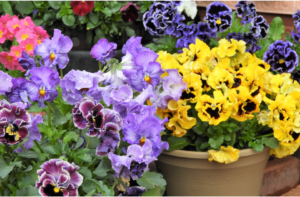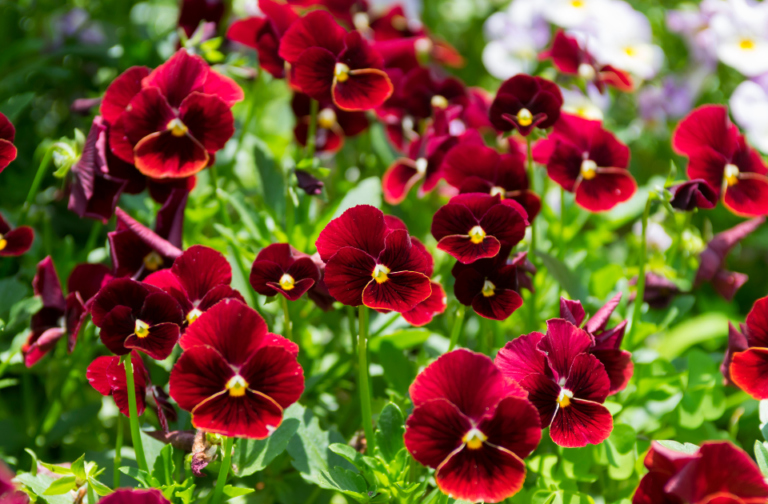Pansies are known for their vibrant colors and cheerful “faces.” Ideal for cooler seasons, these versatile flowers brighten up gardens in spring and fall. Not only are they beautiful, but they’re also edible, adding charm to salads, cakes, and beverages.
This guide will cover all you need to know to ensure your pansies thrive and keep your garden vibrant throughout the year.
History and Origin
Part of the Viola genus, pansies (Viola × wittrockiana) were hybridized in the 19th century from wild violets. They have since become popular worldwide, known for their color combinations and adaptability to various climates.
These flowers are widely loved by gardeners for their ability to thrive in cool conditions and for their stunning seasonal displays.
Types

Popular pansy varieties include:
- Delta Series: Large blooms and heat tolerance.
- Majestic Giants: Oversized, impressive flowers.
- Nature Series: Cold-hardy, great for fall planting.
- Frizzle Sizzle: Ruffled petals for a unique look.
These varieties come in many colors, making them versatile for pairing with other plants or for standalone displays.
How to Plant Pansies
Best Conditions
Pansies thrive in cool weather, making them ideal for planting in spring or fall. They prefer:
- Well-drained, slightly acidic soil with a pH range of 5.5 to 6.5.
- A location that receives partial to full sun, although they appreciate some shade in hotter climates.
For a complete guide on planting pansies, including how to prepare the soil, you can refer to this guide to planting and growing pansies from the Old Farmer’s Almanac.
Steps to Plant
Follow these steps for successful planting:
- Choose the right spot: Ensure good drainage and rich soil.
- Prepare the soil: Add compost or organic material.
- Space properly: Keep 6 to 12 inches between them.
- Water regularly: Maintain moist soil, but avoid overwatering.
- Mulch: Mulching helps retain moisture and keep the soil cool.
If you’re also growing other plants, companion planting can optimize space and provide mutual benefits for your flowers.
Care and Maintenance
Watering and Sunlight
Water regularly but avoid waterlogging, as pansies are sensitive to excess moisture. They enjoy morning sunlight and can tolerate light shade in the afternoon.
Fertilization and Pruning
- Fertilize every two to three weeks with a balanced solution to promote blooms.
- Deadhead spent flowers to encourage further blooming and avoid energy loss.
For dealing with pests like aphids, see this guide to pest control to protect your pansies.
Are Pansies Annual or Perennial?
Pansies can behave as either annuals or perennials, depending on the region. In USDA Hardiness Zones 3-8, they can be treated as short-lived perennials, often surviving light frost and blooming again in the spring.
Common Issues and Solutions
Pansies are hardy but may encounter some issues, such as:
- Root Rot: Caused by overwatering or poorly drained soil. Ensure proper drainage.
- Pests: Aphids and slugs can damage the plants, but introducing natural predators like ladybugs can help.
- Leggy Growth: Trim back leggy plants to encourage compact, healthy growth.
Consider using manure tea to nourish your flowers naturally and keep them strong.
Design Ideas
Pansies offer a range of possibilities for garden design. Use them in:
- Borders: Line garden edges with vibrant pansy varieties.
- Containers: Pansies do well in pots and window boxes, perfect for patios.
- Mixing with Other Flowers: Combine pansies with lobelia, sweet alyssum, or other cool-season flowers for eye-catching displays.
If you’re looking for year-round beauty, plant trees alongside your pansy garden to create a visually appealing landscape.
Edible Uses
Pansies are not only lovely to look at, but also edible. Use them to decorate salads, desserts, and beverages. Always ensure they’re grown organically, without pesticides, before consuming. Wash thoroughly before use to maintain freshness and safety.
FAQs
When is the best time to plant?
The ideal planting time is during the cooler months of spring and fall, when temperatures are moderate. In areas with milder winters, pansies can be planted in fall for extended blooms.
Will they come back every year?
In USDA Zones 3-8, pansies can survive mild winters and come back, acting as perennials. However, in warmer regions, they’re often treated as annuals due to summer heat.
Can they survive frost?
Yes, pansies are frost-tolerant and can survive light frosts, making them a great choice for early spring or fall gardens.
Pansies are a wonderful addition to any garden, providing color, versatility, and even edible benefits. By following these tips and using natural care techniques, your pansies will thrive and brighten your outdoor spaces for months to come.
